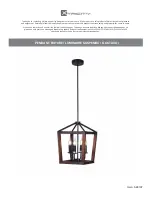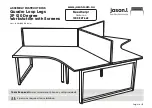
4
INSTRUCTIONS FOR USE
Suggested Instructions for Use
Evolution RL Controlled-Rotation Dilator Sheath Set
WARNING: When using dilator sheaths or sheath sets do not insert more than one sheath set into a
vein at a time. Severe vessel damage, including venous wall laceration requiring surgical repair, may
occur.
SUPERIOR APPROACH
1. Surgically expose the proximal end of the indwelling catheter/lead and remove the catheter/lead from its
connections (if connected). Remove all suture and tie-down materials.
2. Cut off all proximal fittings, if present, using clippers or other cutters. It is important to cut the catheter/
lead very close to the connector (but past any crimp joints) leaving as long a portion of the indwelling
catheter/lead to work with as possible. Avoid closing off the interior lumen (or coil) of the catheter/lead
when cutting it.
3. Consider passing a Locking Stylet through the inner lumen of the catheter/lead to stabilize the catheter/
lead during dilation of surrounding tissues. Closely follow the “Suggested Instructions for Use” for the
Locking Stylet to:
A. Expose the inner coil of the catheter/lead
B. Check patency of the coil lumen
C. Determine the appropriate size of Locking Stylet based on the inner diameter of the catheter/lead
D. Advance the Locking Stylet to the distal end of the catheter/lead
E. Lock the Locking Stylet in place
4. Unless the catheter/lead insulation is damaged, degraded or too thin, tie a ligature or use a compression
coil (Cook) at the proximal end of the catheter/lead, compressing the insulation against the coil and Locking
Stylet to help prevent the coil and insulation from stretching. The ligature can be tied to the loop handle or
to the suture tie loop.
NOTE: If a Locking Stylet has not been used, be aware that damage to the catheter/lead caused by
pulling on it may prevent subsequent passage of a Locking Stylet through the lumen and/or make
dilation of scar tissue more difficult.
5. For an active fixation catheter/lead, attempt to unscrew the catheter/lead by rotating the catheter/lead
and Locking Stylet counterclockwise if appropriate.
6. Gently pull back on the catheter/lead to see if it is still engaged in tissue. If the catheter/lead is sufficiently
loose in the tissue, gently pull on the Locking Stylet and catheter/lead to remove it.
NOTE: If removing a chronic pacing lead, be aware that if it is freed spontaneously during the extraction
procedure, the lead tip may become trapped in the upper vasculature. Dilator sheaths, advanced at least
to the innominate vein, are often necessary to extract the lead tip through the scar tissue at the site of
venous entry, and to avoid a venotomy.
7. If the catheter/lead is not removed from the vessel with gentle pulling then using dilator sheaths,
including the Evolution or Evolution RL Controlled-Rotation Dilator Sheath Set may help separate the
catheter/lead from tissue encapsulation.
8. With the inner Evolution RL Controlled-Rotation Dilator Sheath placed inside the appropriate outer
sheath for telescopic action, insert the proximal free end of the catheter/lead with Locking Stylet in place,
into the distal end of the inner Evolution RL Controlled-Rotation Dilator Sheath. Advance the catheter/lead
with Locking Stylet, until it completely exits the opposite (proximal) end of the sheath set.
9. Apply adequate retracting pressure or tension on the catheter/lead via its Locking Stylet.
This is critical
to safe passage of the sheath set over the catheter/lead. If tension is inadequate, the catheter/lead
may buckle, precluding the sheath set from advancement along the appropriate path.
10. With the catheter/lead in tension, and under fluoroscopic guidance, advance the inner sheath along the
length of the catheter/lead and into the blood vessel. Rotate the inner Evolution® RL Controlled-Rotation
Dilator Sheath, by squeezing and releasing the trigger activation handle.
For Bi-Rotational motion
Squeeze trigger to activate sheath rotation. A return of the trigger to its forward most position will
mechanically change the rotational direction of the sheath to the direction opposite of the last rotation.
Repeat as appropriate.
For Uni-Rotational motion
Squeeze trigger to activate sheath rotation and repeat without allowing trigger to return to its forward
most position. Repeat as appropriate.
Advance the outer sheath over the inner sheath, keeping it within the vessel.
Содержание Evolution RL
Страница 20: ...20 Evolution RL 1 2 3 A B C D E 4 Cook 5 6 7 Evolution Evolution RL 8 Evolution RL Evolution RL...
Страница 21: ...21 9 10 Evolution RL 11 4 cm Evolution RL 12 13 14 Evolution Evolution RL...
Страница 60: ...60 Evolution RL 1 2 3 A B C D E 4 Cook 5 6 7 Evolution Evolution RL 8 Evolution RL Evolution RL...
Страница 61: ...61 9 10 Evolution RL 11 4 Evolution RL 12 13 14 Evolution Evolution RL...
Страница 66: ...66...
Страница 67: ...67...





































